PAPR Reduction in OFDM Signals by Self-Adjustment Gain Method
Abstract
:1. Introduction
2. PAPR Properties of OFDM Signals
3. The Self-Adjustment Gain Method for PAPR Reduction in OFDM Signals
3.1. Clipping and Error Power Measurement
3.2. Signal Detection and Distance Measurement
3.3. Self-Adjustment Gain and Signal Position Update
3.4. Summary of SAG Procedure
- (1)
- The modulated data symbols , are passed through IFFT to generate the OFDM signal . The peak value and average power of are calculated to obtain the PAPR value;
- (2)
- The clipping process is performed according to (4) for all , to obtain the clipped signal . The clipped average power of is calculated;
- (3)
- The is fed into FFT, to obtain the new signal point ;
- (4)
- The detection procedure is performed on , to determine the estimated signal point ;
- (5)
- The residual for each is measured. The corresponding residual power is calculated based on (8) and the self-adjustment gain in (9);
- (6)
- The self-adjustment procedure in (10) is performed, to obtain the updated signal point ;
- (7)
- The updated signal point is passed to IFFT, to obtain the modified OFDM signal ;
- (8)
- The modified OFDM signal is transmitted. The new PAPR value is examined, by calculating the peak value and average power of .
4. Simulation Results and Discussion
5. Conclusions
Author Contributions
Funding
Conflicts of Interest
References
- Wu, Y.; Zou, W.-Y. Orthogonal frequency division multiplexing: A multi-carrier modulation scheme. IEEE Trans. Consum. Electron. 1995, 41, 392–399. [Google Scholar]
- van Nee, R.; Prasad, R. OFDM for Wireless Multimedia Communications; Artech House Inc.: Norwood, MA, USA, 2000. [Google Scholar]
- El-Hajjar, M.; Hanzo, L. A survey of digital television broadcast transmission techniques. IEEE Commun. Surv. Tutor. 2013, 15, 1924–1949. [Google Scholar] [CrossRef] [Green Version]
- Gökceli, S.; Campo, P.P.; Levanen, T.; Yli-Kaakinen, J.; Turunen, M.; Allen, M.; Riihonen, T.; Palin, A.; Renfors, M.; Valkama, M. SDR prototype for clipped and fast-convolution filtered OFDM for 5G new radio uplink. IEEE Access 2020, 8, 89946–89963. [Google Scholar] [CrossRef]
- Jiang, T.; Wu, Y. An overview: Peak-to-average power ratio reduction techniques for OFDM signals. IEEE Trans. Broadcast. 2008, 54, 257–268. [Google Scholar] [CrossRef]
- Declercq, D.; Giannakis, G.-B. Peak to Average Ratio Reduction for Multicarrier Transmission: A Review. Available online: http://citeseerx.ist.psu.edu/viewdoc/download?doi=10.1.1.8.1489&rep=rep1&type=pdf (accessed on 30 May 2021).
- Chauhan, M.; Patel, S.; Patel, H. Different techniques to reduce the PAPR in OFDM system. Int. J. Eng. Res. Appl. (IJERA) 2012, 2, 1292–1294. [Google Scholar]
- Rahmatallah, Y.; Mohan, S. Peak-to-average power ratio reduction in OFDM systems: A survey and taxonomy. IEEE Commun. Surv. Tuts. 2013, 15, 1567–1592. [Google Scholar] [CrossRef]
- Baüml, R.W.; Fischer, R.F.H.; Huber, J.B. Reducing the peak-to-average power ratio of multicarrier modulation by selected mapping. Electron. Lett. 1996, 32, 2056–2057. [Google Scholar] [CrossRef] [Green Version]
- Breiling, M.; Müller, S.H.; Huber, J.B. SLM peak-power reduction without explicit side information. IEEE Commun. Lett. 2001, 5, 239–241. [Google Scholar] [CrossRef]
- Han, S.-H.; Lee, J.-H. Modified selected mapping technique for PAPR reduction of coded OFDM signal. IEEE Trans. Broadcast. 2004, 50, 335–341. [Google Scholar] [CrossRef]
- Ji, J.; Ren, G.; Zhang, H. A semi-blind SLM scheme for PAPR reduction in OFDM systems with low-complexity transceiver. IEEE Trans. Veh. Technol. 2015, 64, 2698–2703. [Google Scholar] [CrossRef]
- Mhatre, K.; Khot, U.-P. Efficient Selective Mapping PAPR Reduction Technique. In Proceedings of the International Conference on Advanced Computing Technologies and Applications (ICACTA-2015), Mumbai, India, 26–27 March 2015; Volume 45, pp. 620–627. [Google Scholar]
- Muller, S.H.; Huber, J.B. OFDM with reduced peak-to-average power ratio by optimum combination of partial transmit sequences. Electron. Lett. 1997, 33, 368–369. [Google Scholar] [CrossRef] [Green Version]
- Kang, S.G.; Kim, J.G.; Joo, E.K. A novel subblock partition scheme for partial transmit sequence OFDM. IEEE Trans. Commun. 1999, 45, 333–338. [Google Scholar]
- Cimini, L.J.; Sollenberger, N.R. Peak-to-average power ratio reduction of an OFDM signal using partial transmit sequences. IEEE Commun. Lett. 2000, 4, 86–88. [Google Scholar] [CrossRef]
- Ho, W.-S.; Madhukumar, A.-S.; Chin, F. Peak-to-average power reduction using partial transmit sequences: A suboptimal approach based on dual layered phase sequencing. IEEE Trans. Broadcast. 2003, 49, 225–231. [Google Scholar]
- Kwon, O.-J.; Ha, Y.-H. Multi-carrier PAP reduction method using sub-optimal PTS with threshold. IEEE Trans. Broadcast. 2003, 49, 232–236. [Google Scholar] [CrossRef] [Green Version]
- Lee, K.-S.; Kang, H.; No, J.-S. New PTS schemes with adaptive selection methods of dominant time-domain samples in OFDM systems. IEEE Trans. Broadcast. 2018, 64, 747–761. [Google Scholar] [CrossRef]
- Mata, T.; Boonsrimuang, P.; Boontra, P. A PAPR Reduction Scheme Based on Improved PTS with ABC Algorithm for OFDM Signal. In Proceedings of the 15th International Conference on Electrical Engineering/Electronics, Computer, Telecommunications and Information Technology (ECTI-CON), Chiang Rai, Thailand, 18–21 July 2018; pp. 469–472. [Google Scholar]
- Zhang, S.-Y.; Shahrrava, B. A hybrid PAPR reduction scheme for OFDM systems using perfect sequences. IEEE Trans. Broadcast. 2020, 66, 177–186. [Google Scholar] [CrossRef]
- Ren, Z.; Hu, Z.; Zhang, H. A high efficiency power amplifier method using signal decomposition in OFDM communication system. IEEE Access 2018, 6, 70248–70258. [Google Scholar] [CrossRef]
- Al-Jawhar, Y.A.; Ramli, K.N.; Mustapha, A.; Mostafa, S.A.; Mohd Shah, N.S.; Taher, M.A. Reducing PAPR with low complexity for 4G and 5G waveform designs. IEEE Access 2019, 7, 97673–97688. [Google Scholar] [CrossRef]
- Idris, A.; Mohd Sapari, N.L.; Syarhan Idris, M.; Sarnin, S.S.; Norsyafizan Wan Mohamad, W.; Naim, N.F. Reduction of PAPR Using Block Coding Method and APSK Modulation Techniques for F-OFDM in 5G System. In Proceedings of the TENCON 2018—2018 IEEE Region 10 Conference, Jeju, Korea, 28–31 October 2018. [Google Scholar]
- Lim, S.-C.; Kim, N.; Park, H. Polar coding-based selective mapping for PAPR reduction without redundant information transmission. IEEE Commun. Lett. 2020, 24, 1621–1625. [Google Scholar] [CrossRef]
- Chauhan, M.; Chobey, A. PAPR Reduction in OFDM system Using Tone Reservation Technique. Int. J. Comput. Technol. Electron. Eng. (IJCTEE) 2012, 2, 4. [Google Scholar]
- Jacklin, N.; Ding, Z. A linear programming based tone injection algorithm for PAPR reduction of OFDM linearly precoded systems. IEEE Trans. Circuits Syst. I 2013, 60, 1937–1945. [Google Scholar] [CrossRef]
- Hou, J.; Ge, J.H.; Gong, F. Tone reservation technique based on peak-windowing residual noise for PAPR reduction in OFDM systems. IEEE Trans. Veh. Technol. 2015, 64, 5373–5378. [Google Scholar] [CrossRef]
- Hou, J.; Zhao, X.M.; Gong, F.K.; Hui, F.; Ge, J.H. PAPR and PICR reduction of OFDM signals with clipping noise-based tone injection scheme. IEEE Trans. Veh. Technol. 2017, 66, 222–232. [Google Scholar] [CrossRef]
- Wang, Y.; Xie, S.; Xie, Z. FISTA-based PAPR reduction method for tone reservation’s in OFDM system. IEEE Wireless Commun. Lett. 2018, 7, 300–303. [Google Scholar] [CrossRef]
- Krongold, B.S.; Jones, D.L. Par reduction in ofdm via active constellation extension. IEEE Trans. Broadcast. 2003, 49, 258–268. [Google Scholar] [CrossRef] [Green Version]
- Tahkoubit, K.; Ali-Pacha, A.; Shaiek, H.; Roviras, D. Iterative Dichotomy PAPR Reduction Method for Multicarrier Waveforms. IEEE Commun. Lett. 2019, 23, 2073–2076. [Google Scholar] [CrossRef]
- Ding, G.; Feng, Q.; Pang, J.; Yin, R.; Yu, G. Unitary matrix method for PAPR reduction of IDFT-VFDM signals. IEEE Wirel. Commun. Lett. 2020, 9, 2107–2111. [Google Scholar] [CrossRef]
- Zheng, Z.; Li, G. An efficient FPGA design and performance testing of the ACE algorithm for PAPR reduction in DVB-T2 Systems. IEEE Trans. Broadcast. 2017, 63, 134–143. [Google Scholar] [CrossRef]
- Zhou, Y.; Jiang, T. A Novel Clipping Integrated into ACE for PAPR Reduction in OFDM Systems. In Proceedings of the 2009 International Conference on Wireless Communications & Signal Processing, Beijing China, 24 September 2009. [Google Scholar]
- Horváth, B.; Kollár, Z.; Horváth, P. Bridging the Gap between Optimal and Suboptimal ACE PAPR Reduction Scheme for OFDM. In Proceedings of the 2014 24th International Conference Radioelektronika, Bratislava, Slovakia, 15–16 April 2014. [Google Scholar]
- Han, Q.; Zeng, X.; Zeng, L.; Wang, T. Joint PAPR Reduction Method Base on ACE POCS and Peak Clipping. In Proceedings of the 2010 International Conference on Cyber-Enabled Distributed Computing and Knowledge Discovery, Huangshan, China, 10–12 October 2010. [Google Scholar]
- Liu, Y.; Wang, Y.; Ai, B. An efficient ACE scheme for PAPR reduction of OFDM signals with high-order constellation. IEEE Access 2019, 7, 118322–118332. [Google Scholar] [CrossRef]
- Samayoa, Y.; Ostermann, J. Modified Active Constellation Extension Algorithm for PAPR Reduction in OFDM Systems. In Proceedings of the 2020 Wireless Telecommunications Symposium (WTS), Washington, DC, USA, 22–24 April 2020. [Google Scholar]
- Liu, Y.; Wang, Y. Novel ACE Scheme for PAPR Reduction of High Broadband OFDM Systems. In Proceedings of the 2019 IEEE 19th International Conference on Communication Technology (ICCT), Xi’an, China, 16–19 October 2019. [Google Scholar]
- Wang, L.; Tellambura, C. A simplified clipping and filtering technique for PAR reduction in OFDM systems. IEEE Signal Process. Lett. 2005, 12, 453–456. [Google Scholar] [CrossRef]
- Sezginer, S.; Sari, H. OFDM peak power reduction with simple amplitude predistortion. IEEE Commun. Lett. 2006, 10, 65–67. [Google Scholar] [CrossRef]
- Li, X.; Cimini, L.J. Effects of clipping and filtering on the performance of OFDM. IEEE Commun. Lett. 1998, 2, 131–133. [Google Scholar] [CrossRef]
- Gökceli, S.; Levanen, T.; Riihonen, T.; Yli-Kaakinen, J.; Brihuega, A.; Turunen, M.; Renfors, M.; Valkama, M. Novel iterative clipping and error filtering methods for efficient PAPR reduction in 5G and beyond. IEEE Open J. Commun. Soc. 2021, 2, 48–66. [Google Scholar] [CrossRef]
- Jiang, T.; Yang, Y.; Song, Y. Exponential companding transform for power reduction in OFDM systems. IEEE Trans. Broadcast. 2005, 51, 244–248. [Google Scholar] [CrossRef]
- Wang, Y.; Wang, L.-H.; Ge, J.-H.; Ai, B. An efficient nonlinear companding transform for reducing PAPR of OFDM signals. IEEE Trans. Broadcast. 2012, 58, 677–684. [Google Scholar] [CrossRef]
- Wang, Y.; Wang, L.H.; Ge, J.H.; Ai, B. Nonlinear companding transform for reduction of peak-to-average power ratio in OFDM systems. IEEE Trans. Broadcast. 2013, 59, 369–375. [Google Scholar] [CrossRef]
- Hu, M.; Li, Y.; Wang, W.; Zhang, H. A piecewise linear companding transform for PAPR reduction of OFDM signals with companding distortion mitigation. IEEE Trans. Broadcast. 2014, 60, 532–539. [Google Scholar]
- Anoh, K.; Adebisi, B.; Rabie, K.M.; Tanriover, C. Root-based nonlinear companding technique for reducing PAPR of precoded OFDM Signals. IEEE Access 2017, 6, 4618–4629. [Google Scholar] [CrossRef]
- Del Marco, S.P. A constrained optimization approach to compander design for OFDM PAPR reduction. IEEE Trans. Broadcast. 2018, 64, 307–318. [Google Scholar] [CrossRef]
- Hu, M.; Wang, W.; Cheng, W.C.; Zhang, H. A generalized piecewise linear companding transform for PAPR reduction in OFDM systems. IEEE Trans. Broadcast. 2020, 66, 170–176. [Google Scholar] [CrossRef]
- Mohammed, A.; Ismail, T.; Nassar, A.; Mostafa, H. A novel companding technique to reduce high peak to average power ratio in OFDM systems. IEEE Access 2021, 9, 35217–35228. [Google Scholar] [CrossRef]
- Al-Gharabally, M.; Almutairi, A.F.; Krishna, A. Performance analysis of the two-piecewise linear companding technique on filtered-OFDM systems. IEEE Access 2021, 9, 48793–48802. [Google Scholar] [CrossRef]
- Sohn, I.; Kim, S.C. Neural network based simplified clipping and filtering technique for PAPR reduction of OFDM signals. IEEE Commun. Lett. 2015, 19, 1438–1441. [Google Scholar] [CrossRef]
- Kim, M.; Lee, W.; Cho, D.-H. A novel PAPR reduction scheme for OFDM system based on deep learning. IEEE Commun. Lett. 2018, 22, 510–513. [Google Scholar] [CrossRef]
- Haykin, S. Adaptive Filter Theory, 4th ed.; Prentice-Hall Inc.: Upper Saddle River, NJ, USA, 2002. [Google Scholar]
- Xing, Z.; Liu, K.; Rajasekaran, A.S.; Yanikomeroglu, H.; Liu, Y. A hybrid companding and clipping scheme for PAPR reduction in OFDM systems. IEEE Access 2021, 9, 61565–61576. [Google Scholar] [CrossRef]
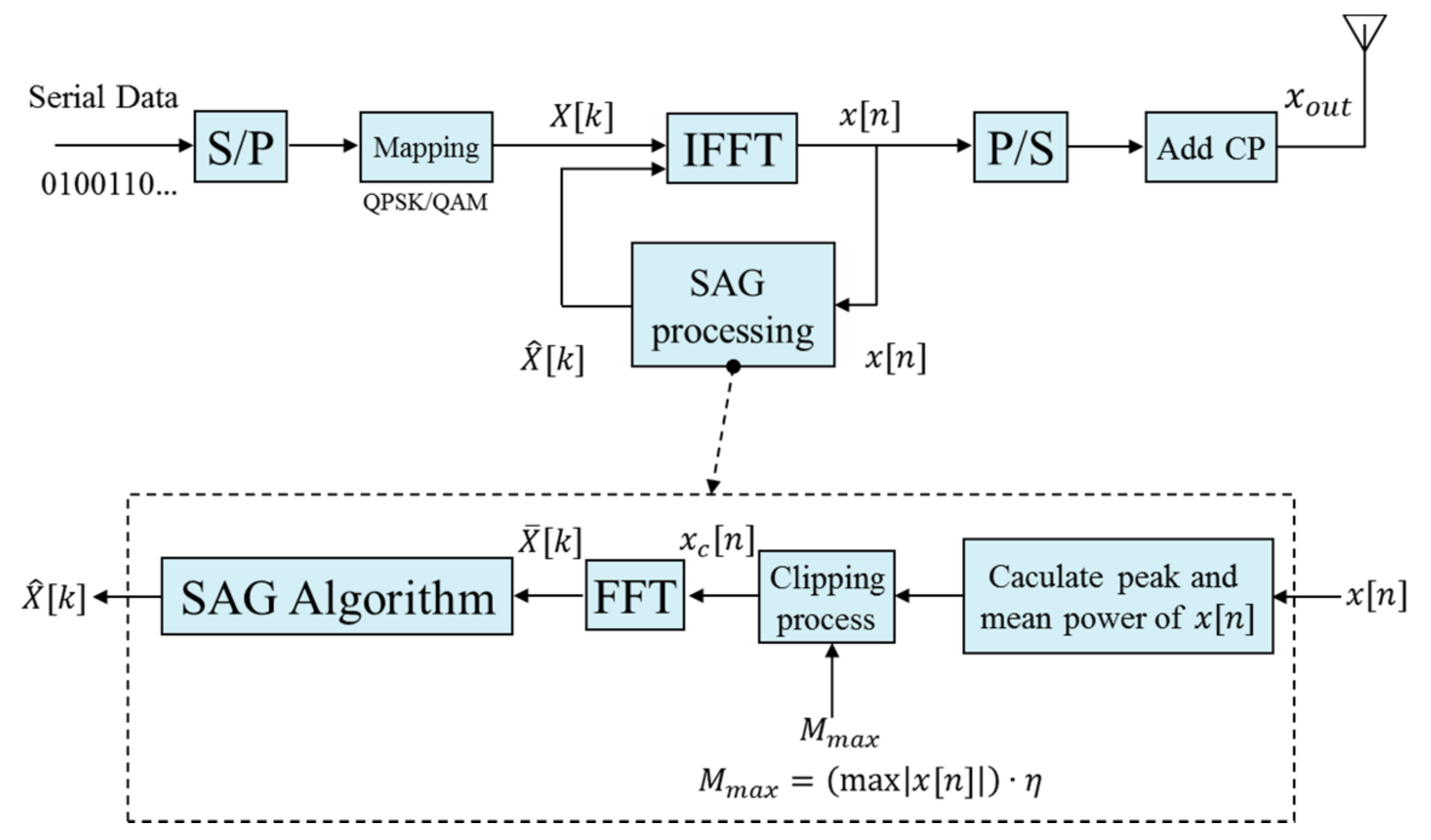
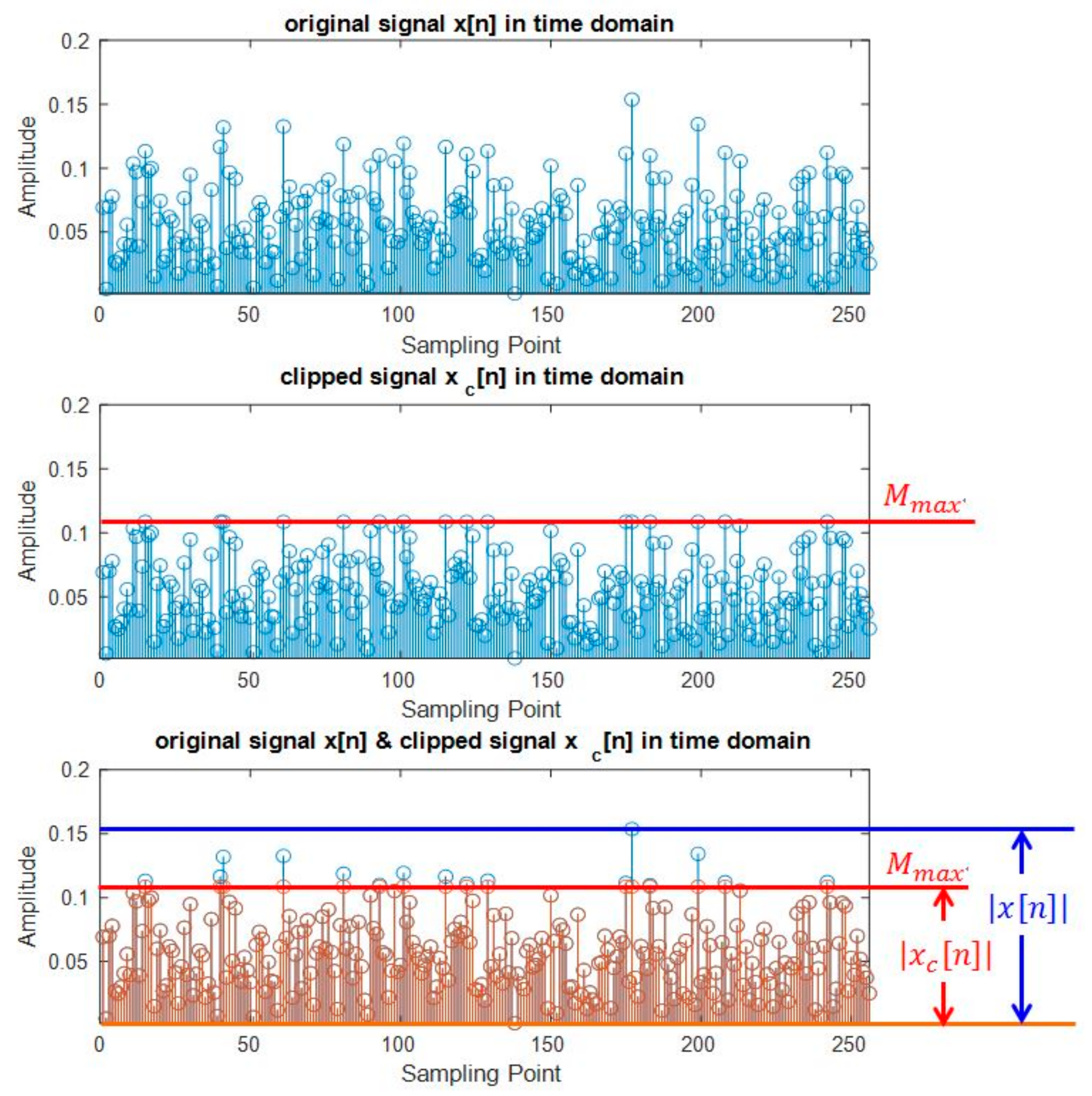
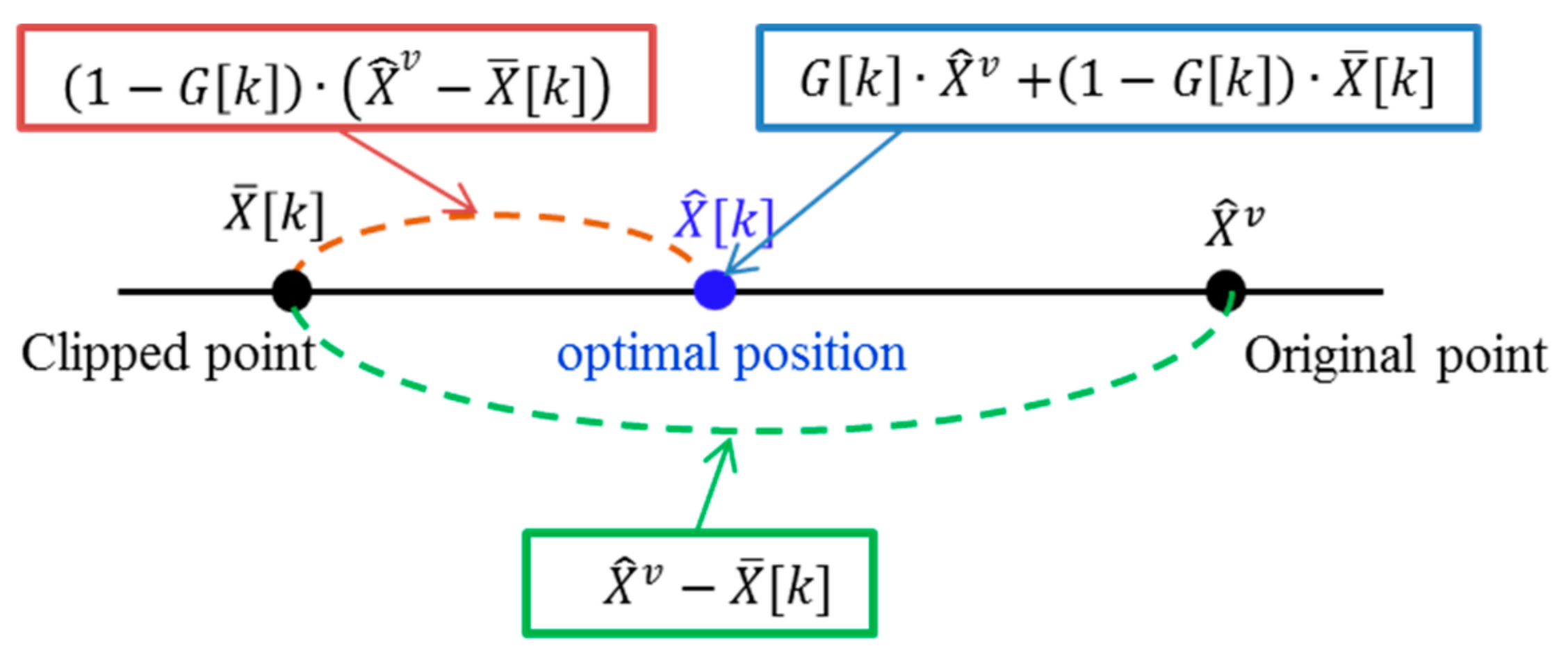


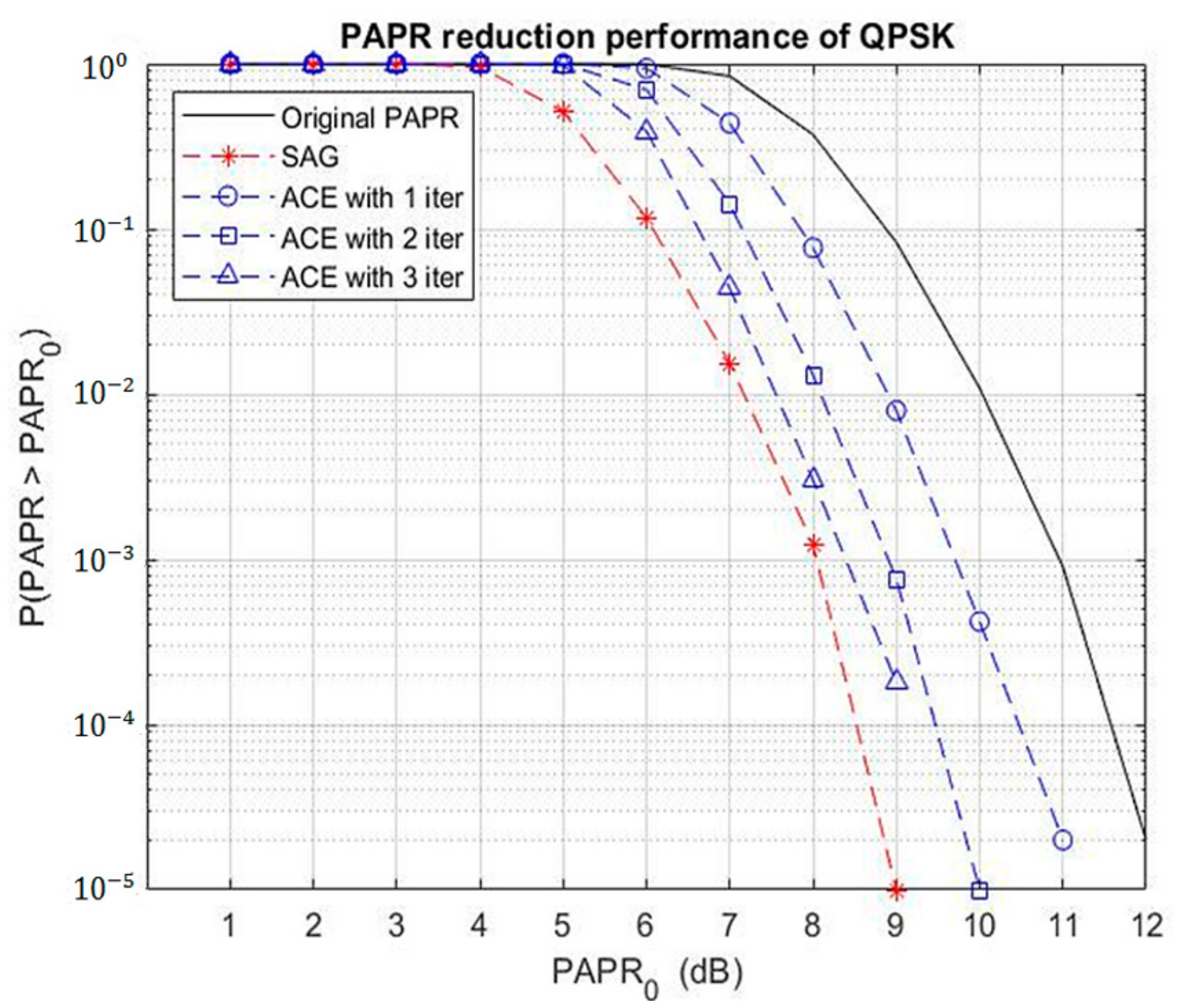
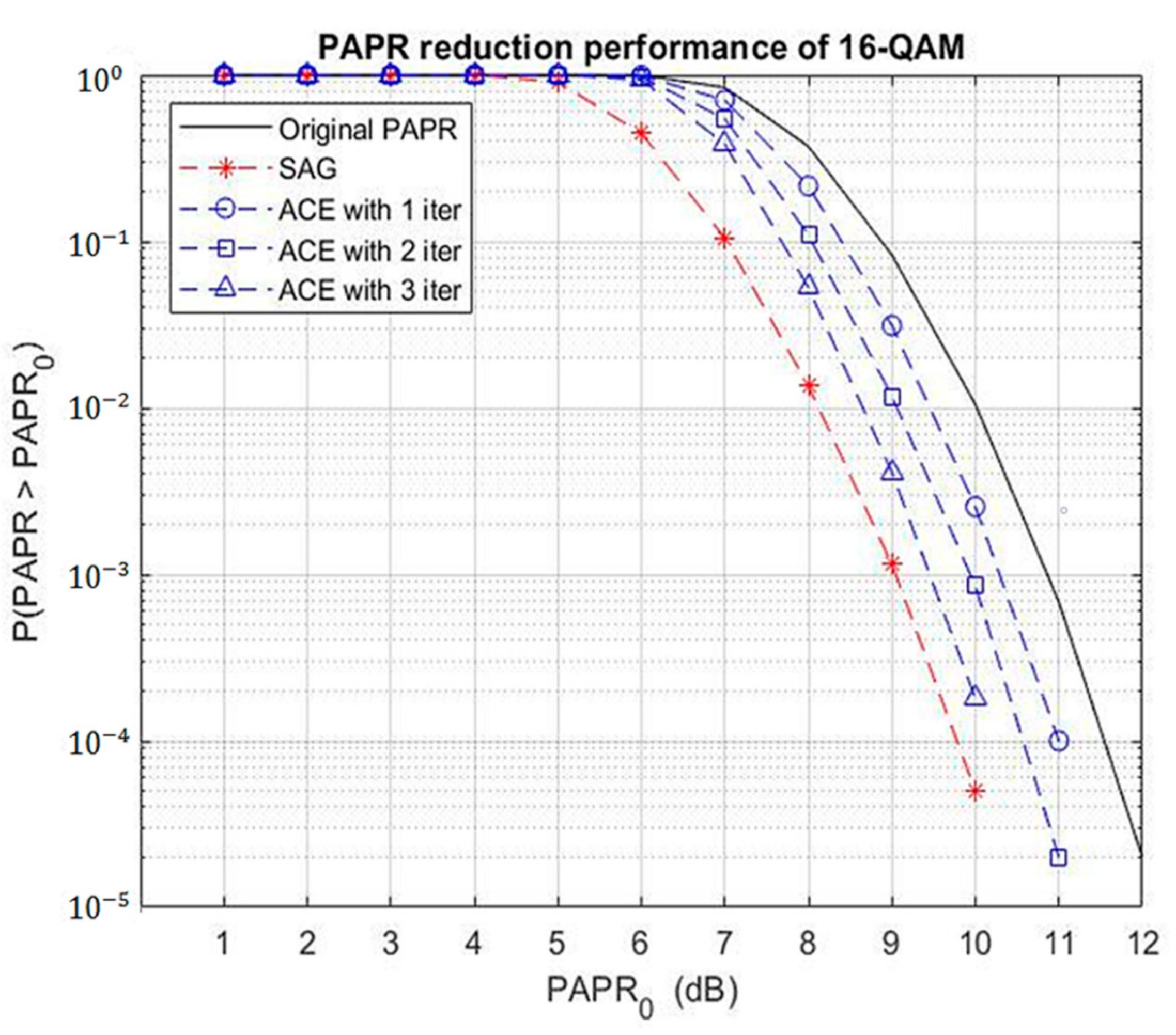

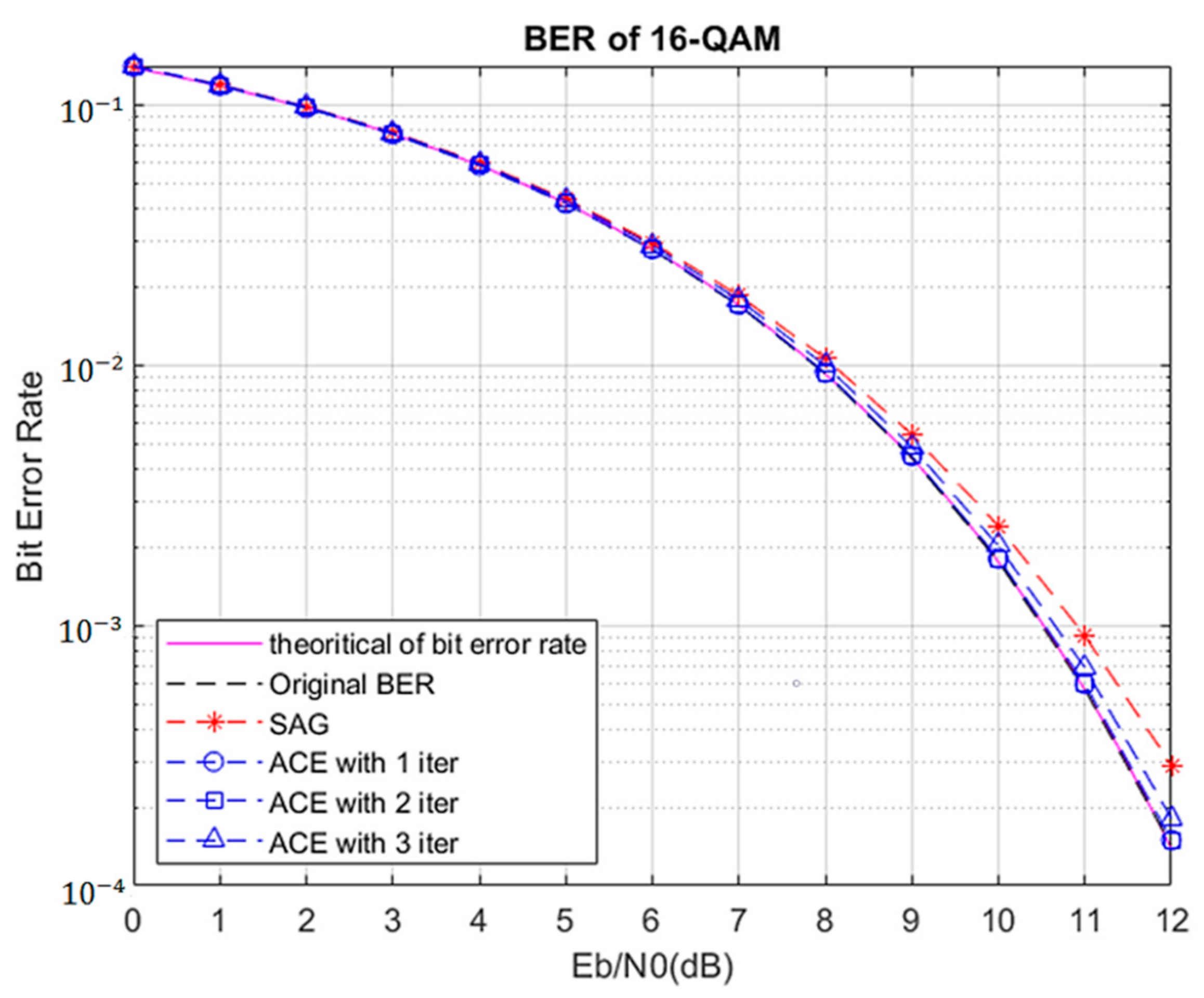
| Method | Amplitude Clipping | Partial Transmit Sequence | Selective Mapping | Active Constellation Extension | Coding | |
|---|---|---|---|---|---|---|
| Item | ||||||
| Power Increasing | No | No | No | Yes | No | |
| BER Increasing | Yes | Yes | Yes | No | Yes | |
| Data Rate Loss | No | Yes | Yes | No | Yes | |
| Signal Distortion | Yes | No | No | No | No | |
| Computational Complexity | Low | High | Medium | Medium | Low | |
| Method | Original | Proposed SAG | ACE | ACE-POCS | ACE-SGP | mACE | |
|---|---|---|---|---|---|---|---|
| Item | |||||||
| # of Iterations | - | 1 | 3 | 3 | 3 | 3 | |
| PAPR(dB) | 11.6 | 8.5 | 9.2 | 9.7 | 7.7 | 7.2 | |
| Method | Original | Proposed SAG | ACE | ACE-POCS | ACE-SGP | mACE | |
|---|---|---|---|---|---|---|---|
| Item | |||||||
| # of Iterations | - | 1 | 3 | 3 | 3 | 3 | |
| PAPR(dB) | 11.6 | 9.8 | 10.2 | 10.8 | 8.6 | 8.5 | |
Publisher’s Note: MDPI stays neutral with regard to jurisdictional claims in published maps and institutional affiliations. |
© 2021 by the authors. Licensee MDPI, Basel, Switzerland. This article is an open access article distributed under the terms and conditions of the Creative Commons Attribution (CC BY) license (https://creativecommons.org/licenses/by/4.0/).
Share and Cite
Hao, M.-J.; Pi, W.-W. PAPR Reduction in OFDM Signals by Self-Adjustment Gain Method. Electronics 2021, 10, 1672. https://doi.org/10.3390/electronics10141672
Hao M-J, Pi W-W. PAPR Reduction in OFDM Signals by Self-Adjustment Gain Method. Electronics. 2021; 10(14):1672. https://doi.org/10.3390/electronics10141672
Chicago/Turabian StyleHao, Miin-Jong, and Wei-Wu Pi. 2021. "PAPR Reduction in OFDM Signals by Self-Adjustment Gain Method" Electronics 10, no. 14: 1672. https://doi.org/10.3390/electronics10141672
APA StyleHao, M.-J., & Pi, W.-W. (2021). PAPR Reduction in OFDM Signals by Self-Adjustment Gain Method. Electronics, 10(14), 1672. https://doi.org/10.3390/electronics10141672







